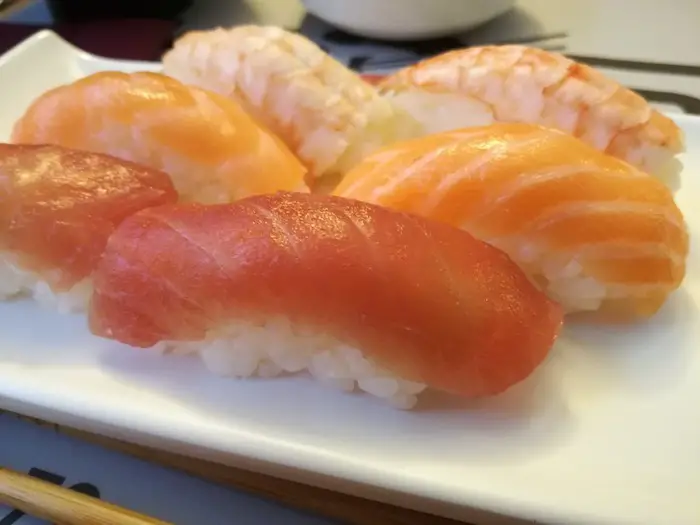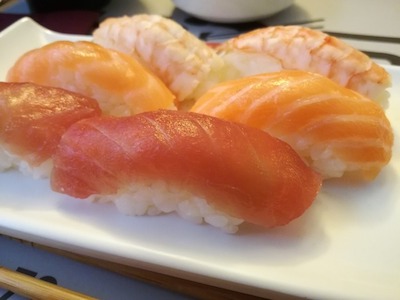We are reader supported. When you purchase through links on our site, we may earn an affiliate commission. Also, as an Amazon affiliate, we earn from qualifying purchases.

Sushi (nowadays) seems to be the ultimate in sophisticated grab-and-go food! People of all ages are enjoying its many fresh, delicious varieties. One particular type that is quickly gaining popularity in the West is nigiri sushi.
What is nigiri sushi? Nigiri sushi is a Japanese food consisting of small balls of cold, cooked white rice that is topped with raw fish (or seafood) and served with wasabi. It is eaten by hand immediately and is often dipped into soy sauce prior to consuming.
Let’s explore this unique type of sushi in more detail below. We will begin by discussing what nigiri sushi is, exactly…
Contents
What is a Nigiri Sushi Roll?
Nigiri is short for ‘nigrizushi’ and is found in sushi restaurants worldwide. Unlike other sushi (maki) that is rolled in seaweed, nigiri is simply a ball of vinegar-flavored rice topped with thinly-sliced raw fish. It is often suggested that first-time sushi diners begin with nigiri, as it easy to eat and offers a unique taste.
Nigiri means ‘two fingers’ in Japanese and gets its name from its ability to fit comfortably between the chef’s two fingers when pressing or preparing. This type originated in Edo which is now present-day Tokyo. Is often referred to as Edo-Mae in Japan.
Nigiri is always made with fish, never meat. Vinegar-flavoured rice is ‘pressed’ by hand into a ball shape and topped with fish and a dollop of wasabi. It is served with pickled ginger and soy sauce on the side.
Types of fish often used for nigiri include tuna, salmon, halibut, yellowtail, eel, and shrimp. Because these fish are easier on the palate, they are great for those new to sushi-eating. Once accustomed to this type of sushi, you can be more adventurous and try other fish varieties with your nigiri such as octopus, squid, crab, and abalone.
How Many Calories are in Nigiri Sushi?
Calorie count in nigiri sushi depend upon the type of fish used. One piece of nigiri ranges from forty calories (if made with squid or octopus) to fifty calories (when salmon or yellowtail is used) or sixty-five calories (using eel or sea urchin).
As a meal, nigiri is a great, healthy choice. It is loaded with heart-healthy omega-3 fatty acids (thanks to the fish), is low in calories and has no added fat. Not only is it healthy but it is also delicious! If prepared properly, the flavors and textures are perfectly balanced which makes it very pleasing to the palate.
How to Eat Nigiri Sushi
There are essentially eight steps to eating nigiri sushi. These include the following:
Wash you hands
Some sushi restaurants will go so far as to offer you a hot towel to wipe your hands at the beginning of the meal. If you are not given a towel then proceed to the bathroom and wash your hands thoroughly with soap and water. If you choose take-out sushi then use a drop of hand sanitizer to clean your hands.
Use your thumb and middle finger to hold the sushi
Pick up the nigiri with your dominant hand and hold onto it comfortably – not too tight. Never pick up nigiri with chopsticks. It is too awkward with chopsticks and will fall apart. Proper sushi-etiquette does not apply in this case.
Pour some soy sauce into the shoyu bowl
With your other hand, pour a small amount of soy sauce into the side dish, just enough to dip the nigiri into it. Never pour soy sauce directly over the sushi as this will not only ruin the flavor but also make it difficult to hold onto afterward.
Flip the sushi over and dip into the shoyu bowl
Grasping the nigiri between your thumb and forefinger, flip it so that the fish side is facing downward and then lightly dip it into the soy sauce. Do not drown the sushi in soy sauce. A high-quality piece of nigiri requires very little (if any) soy sauce to enhance the flavor.
Add a small amount of wasabi to it
Before eating, place a dollop of wasabi on top for added flavor. Nigiri is made with a dab of wasabi already, placed between the rice and the fish. Only add a small amount of additional wasabi if you like your sushi on the spicier-side!
Eat in one bite
Nigiri is made bite-sized and meant to be consumed all at once. If one bite seems too much for you then eat in two bites, but no more. Avoid tearing the sushi with your teeth or pulling it apart with your hands as this will compromise both its texture and taste.
Eat pickled ginger between bites
Pickled ginger like this helps clean the palate between bites of sushi. Do not eat pickled ginger with nigiri as this will compromise the flavor profile.
Wash your hands after eating.
To avoid an unpleasant hand-to-eye experience, wash your hand after eating sushi. Wasabi and soy sauce will sting the eyes if contact is made.
For more information: How To Eat Sushi In Japan (Sushi Eating Etiquette)
How to Make Nigiri Sushi?
Making nigiri sushi is fun to do, on your own and/or with friends. It can be tricky to master the art of sushi making (people train for years to become senior chefs at the top-rated sushi restaurants worldwide), but with a little practice (and patience), one can become a sushi master! Follow these six simple steps below:
Prepare the rice
Pre-cook white rice and allow to cool completely. Click here to step-by-step instructions
Set-up the work station
Be sure to have a cutting board, chef’s knife, damp towel, pickled ginger, wasabi, sushi rice, and fish ready to go.
Wet your hands
This prevents the rice from sticking to your fingers while you shape it.
Shape the rice

Take a small amount of sticky rice and press it into an oval shape. Use your thumb and middle finger to shape the sides.
Add the fish
Add a piece of finely cut fish (pre-cut just before you begin to make the process easier) to the top of the handmade nigiri roll. Beforehand, it is recommended to add a dab of wasabi to the center of the fish, which will not only add delicious flavor but also prevent the fish from sticking to the rice.
Dip and eat.
Indulge in this delicious sushi feast with soy sauce (in a side bowl for dipping), wasabi (an extra dollop on top for zesty flavor) and whatever else you like to eat with raw fish dishes. No feed for chopsticks. It is okay to eat with your hands like the ‘pros’ do!
Related Questions:
Is it safe to eat raw fish?
Raw fish, if previously frozen to kill any parasites that may be present, is usually considered ‘safe’ to eat. However, it is best to pre-cook seafood before consumption to lower the risk of contracting a foodborne illness.
The freshest (and perhaps best) option for raw fish intended for use in sushi-making is often marked as ‘sushi grade’. It is of the highest quality available on the market today and is the top-choice of master sushi chefs. It can be purchased online, at your local Japanese market or through a fishmonger at your local grocery store.
Nigiri vs sashimi vs maki: what is the difference?
Nigiri is a hand-formed ball of vinegar-flavored rice with a slice of raw fish (not meat) on top. Sashimi is made from an assortment of raw fish (or meat) and served without rice. Maki is a traditional sushi roll consisting of fish, vegetables, and rice rolled in seaweed.
All three varieties tend to be served with condiments, such as soy sauce, wasabi and pickled ginger. Each has its own unique preparation method also.
For more info: Difference Between Nigiri, Sashimi, Sushi Roll, Hand Roll, Gunkan Sushi
Is it rude to eat sushi by hand?
It is not rude to eat sushi by hand. Though eating with chopsticks is often considered proper ‘sushi-etiquette’, sushi such as nigiri is meant to be eaten by hand, immediately and in a single bite!
Why is wasabi used for sushi?
Wasabi is used in sushi making for two reasons. Firstly, it adds delicious zesty flavor to the sushi. Secondly, it effectively suppresses microbes and bacteria that can reside in raw fish and cause food poisoning.
Conclusion
In conclusion, nigiri is a popular Japanese food that is often considered the ‘original’ sushi. It is made by laying a slice of raw fish across an oval-shaped roll of sticky rice. To keep the fish from sliding off the top, a dab of wasabi is used to ‘glue’ it down. No other sauces are required to hold the nigiri structure together.
It is often considered to be one of the freshest and lightest tasting sushi options available. It is a great choice for vegetarians as it can be made from meat alternatives, such as tofu or edamame. Unlike other sushi varieties, nigiri is eaten by hand and served with a delicious assortment of condiments.
Next time you visit your favourite sushi establishment, try the nigiri on the menu, especially if you are new to sushi dining. It is bound to be a palate-pleaser, with its balanced texture, fresh flavor and exotic taste. Bon apetit (or ‘itadakimasu’ in Japanese)!


